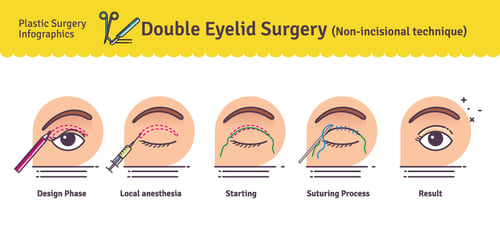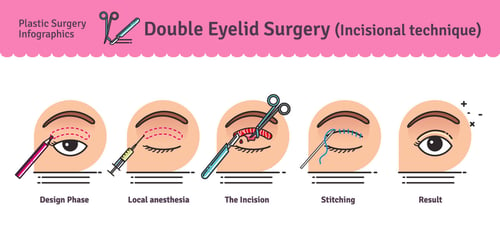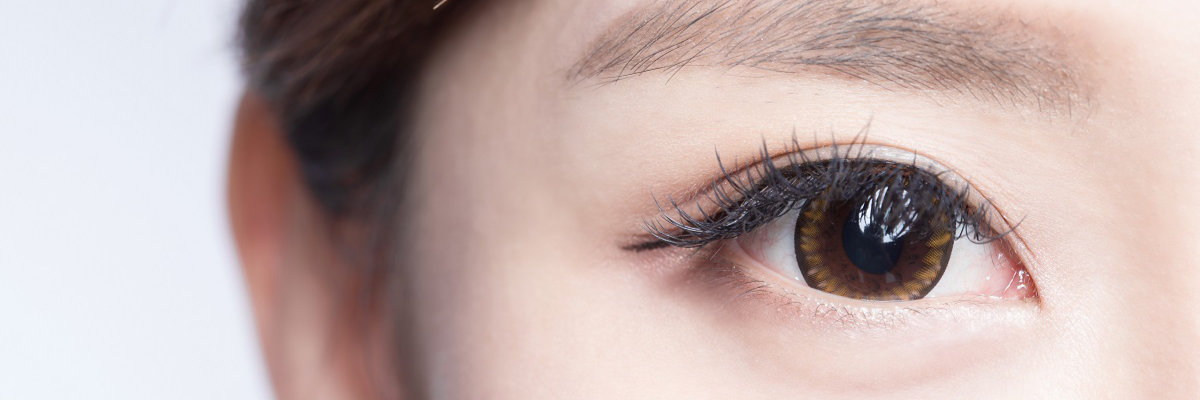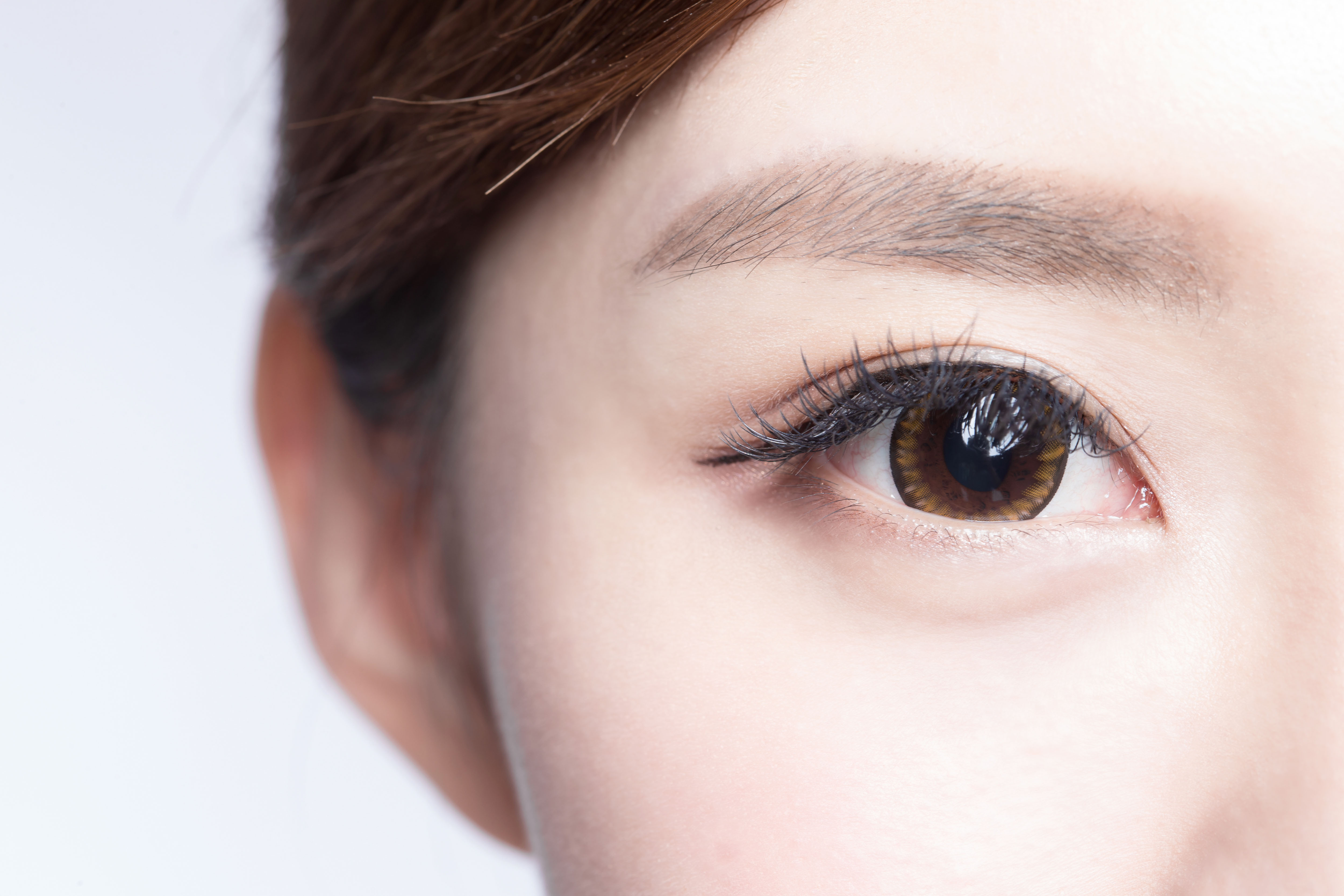Aesthetic Procedures: Double Eyelid Creation
Double Eyelid Creation & Surgery in Singapore
In East Asians, this crease is often lower or absent, leading to the ‘single-eyelid’ appearance. Whilst lower folds can suit some faces well, they often lead to a tired or dull appearance. Surgical techniques that have been developed to help with double eyelid creation include suture (‘scarless’) or the incisional technique. Your plastic surgeon will assess and discuss the best option for you.
Suture (‘Scarless’) Double Eyelid Creation
ADVANTAGES
The advantages of the suture technique are reduced downtime (3 to 5 days of swelling compared to 2 weeks in the open technique), no suture removal, and reduced risk of a visible upper eyelid scar. However, there is a risk that the suture material is insufficient to maintain the double eyelid and the double eyelid may lower or disappear.
WHO IS THIS METHOD SUITABLE FOR?
The suture technique is suitable for patients whose upper eyelids are not too heavy and who do not desire a drastic change in appearance. It is a repeatable procedure, though in patients who have failed previous suture upper blepharoplasty, an incisional technique is recommended.

Incisional Double Eyelid Creation
ADVANTAGES
The advantages of the incisional technique are the ability to accurately visualize and approximate the correct tissue layers and control the fold in the manner desired. Its disadvantages include a longer upper eyelid scar and more swelling and bruising, both of which may take a few weeks to heal.
WHO IS THIS METHOD SUITABLE FOR?
The incisional technique is suitable for patients who have heavier upper eyelids or who require concurrent procedures such as removal of excess skin or fat and can tolerate a few weeks of downtime. Ultimately, it provides better control to the double eyelid creation.

Who May Benefit from Double Eyelid Surgery?
Double eyelid surgery/ blepharoplasty is also a suitable treatment for people with trichiasis, an irritating eye condition characterized by inward growing lashes. In fact, both of the abovementioned forms of double eyelid surgery can help to prevent the eyelashes from reaching the eyes.
Last but not least, double eyelid surgery may also be ideal for people who experience asymmetry of the eyelids as a result of genetic predisposition, injuries, complications of previous eyelid procedures, etc. By creating a matching eyelid crease on the affected eye, this procedure helps to restore eye symmetry and boost the patient’s confidence.
Pre-Surgery Preparation and Post-Operative Care
Every surgery, big or small, comes with a checklist of Dos and Don’ts. While it is advisable to check with your doctor regarding the specific instructions, here are some things to take note.
Prior to Surgery
Don’t
- Consume alcohol and caffeine 48 hours prior to surgery.
- Consume tobacco products a few weeks prior to surgery.
- Consume food or drinks after 12 midnight, the night before your surgery.
- Wear contact lenses or fake eyelashes the day of surgery.
Do
- Arrange for an escort or companion to take you home after your surgery.
- Arrange for a car ride home after your surgery.
- Wear comfortable clothes on the day of your surgery.
Post-Surgery
Don’t
- Consume alcohol, tobacco products, and caffeine.
- Engage in straining activities or vigorous exercises for 2 weeks.
- Use the hot tub or sauna for 6 weeks.
- Put anything frozen directly on your face.
- Get exposed to the sun if possible.
Do
- Sleep on your back with your head elevated for the next 2 weeks.
- Contact your doctor immediately if you experience progressive or one-sided pain, bleeding, bruising, swelling, or visual changes.
- Clean the stitches around your eyes and apply the prescription ointment on the stitches 2-3 times a day.
- Eat a well-balanced diet, with increased fluids such as water and fruit juices.
- Abide by your post-operative schedule.
The Polaris Approach
At Polaris Plastic & Reconstructive Surgery, we combine modern aesthetic procedures with complementary treatments to attain realistic, natural-looking and long-lasting outcomes. Consultant plastic surgeons Dr Adrian Ooi and Dr Pek Chiong Han exercise a “patient-first” approach that focuses on embracing individual uniqueness with highly customised treatment plans, and ensuring a smooth and rapid recovery for patients by harnessing advanced plastic surgery techniques and technology.
PATIENT STORIES
Post Massive Weight Loss Body Contouring
A 40-year-old lady consulted with Dr Pek with the desire to correct large amounts of excess skin and soft tissue. She had undergone Bariatric Surgery (Sleeve Gastrectomy) 2 years prior to her presentation and had successfully lost almost 30kg of weight. With ... Read more
Treating Gynecomastia – Correct Male Breasts through minimally invasive techniques
A 38-year-old male engineer presented to Dr Pek with symptomatic growth of his chest/breast area. Since puberty, he complained of unusually prominent chest tissue around his nipple and areolar region. This had worsened gradually over the years, with the left ... Read more
Upper eyelid lift and eyebags rejuvenation
63 years old Chinese female with hypertension and hyperlipidemia presented to Dr Pek with significant droopiness of her upper eyelids on both sides, affecting the upper portion of her visual field. She would constantly feel that her upper eyelids were heavy, ... Read more
Bilateral breast reconstruction using abdominal free flaps
A 45-year-old mother of 2 children was diagnosed with left breast cancer, for which a skin-sparing mastectomy (total removal of breast tissue leaving behind the skin envelope) was recommended. Read more
ARTICLES
Let's be real, we all have those areas of our body where ...
Rhinoplasty, commonly known as a nose job, is a surgical ...
Plastic reconstructive surgery is a specialised field that ...
Droopy eyelids are not just a cosmetic concern. While it ...
Contact Form
1 Orchard Boulevard #10-08 Camden Medical Centre, Singapore 248649
6 Napier Rd, #08-01 Gleneagles Medical Center, Singapore 258499
Tel: +65 6737 4565 | Mobile: +65 8828 4565 | Email: clinic@polarisplasticsurgery.com | Business Hours: Mon - Fri: 9am - 6pm | Sat: 9am - 1pm | Sun/Ph: Closed







